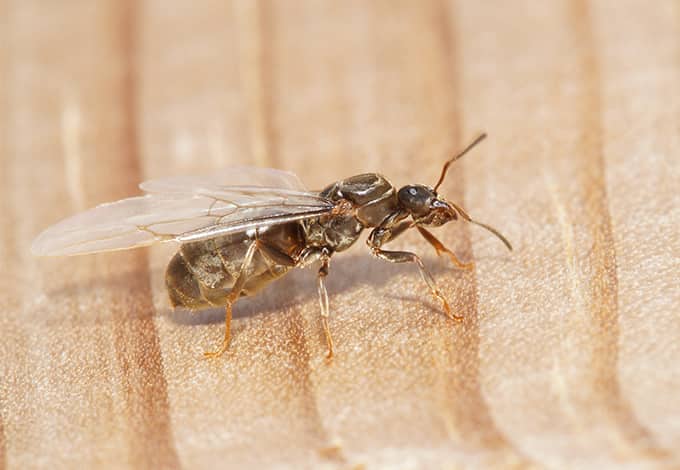

Flying Ants Or Swarming Termites?
There are lots of winged insects in the world. This makes it hard to recognize a wood-destroying pest when we see one. But it is actually easier than you might think. Let's take a look.
Flying Ants
The ant that chews on a home's wood is a carpenter ant, and carpenter ants are the largest ant you're going to see climbing (hopefully, on the outside) of your home. A carpenter ant swarmer can be as long as an inch in length. They are usually black, but they may be a mix of black, dark red, and yellow, depending on what species you're looking at. And, being a large ant, you'll be able to look to see if it has 1 node between its thorax and abdomen. If it does, you have yourself a carpenter ant.

Subterranean Termites
While termites are much smaller than carpenter ants, they also have a distinct appearance that makes it easy to identify them. Most termites are pale to yellowish in color, but you're not likely to see them. Those are worker termites, and they live inside the ground or inside the wood, they're feeding on. The termites you'll see crawling on your home are called swarmers. These are male and female winged alates that are produced by a mature nest to create new nests. Alates are black with long white wings that stack on top of each other and extend well beyond the end of the abdomen. If you see a black insect with long white wings, you're likely looking at a subterranean termite.
Is It Important To Be Able To Tell The Difference?
If you identify either of these two insects crawling on your property, it is time to call a pest control company, but it is important to know that carpenter ants and termites do not present the same threat to your equity. There are three main reasons why.
- Carpenter ants don't consume wood. Your home is not a food source for these insects. They create tunnels and galleries in wood to establish a safe place to put their nests. Their goal is not to systematically consume every inch of your support timbers.
- Subterranean termites eat wood. When a carpenter ant infestation takes root in a structure, it is often detected because of the frass (sawdust) that carpenter ants push out of their tunnels. When deposited in a location that can be seen, this frass will prompt a property owner to take action. Termites eat wood. They do not need to push anything out of their tunnels. So they can feed on a structure for years without being detected.
- Subterranean termites need moisture. When these termites are exposed to the drying effects of air and sunlight, they dry up and die. Carpenter ants do not. So, unless you're ripping out a wall to do some new construction, you're probably not going to see termite workers crawling around. You may, however, see carpenter ant workers, especially scouts, which will crawl around inside your home looking for food sources.
- Statistics. We could give many examples for why termites are more destructive than carpenter ants, but, at the end of the day, statistics tell the story. In the United States, carpenter ants are a million-dollar problem. Termites are a billion-dollar problem.
Pest Control
When protecting your property from these two pests, it is always best to partner with a certified termite control professional. Though the methods and products for ants and termites are different, both pests are difficult to control. And both can elude inspections.
As you search for a pest control company, keep in mind that all pest control companies are not created equal. If you're not in our New York service area, find a company like Parkway Pest Service. One that has earned the QualityPro seal of excellence from the National Pest Management Association. This seal is your assurance that the pest control provider has undergone rigorous auditing from a trusted 3rd party. And make sure the company backs its pest control with a 100% satisfaction guarantee.
Contact us for fast assistance and effective results if you live in NYC, Brooklyn, Long Island, or Five Boroughs. No home should ever be without protection from wood-destroying insects.
Customer Testimonials
-
Excellent, prompt, and courteous service. The technician arrived on time and took care of our yellowjacket nest and carpenter bee problems. Highly recommend Parkway if you have pest issues.- Jeff R.
-
Professional, knowledgeable, and great service. The technicians are always on time and the pest issues are solved within a couple of days. Highly recommend Parkway Pest Services for any pest problem. Thank you!- Jean R.
-
Parkway Pest Services responded very quickly to our request to have a tech come and inspect our rodent issue. They provided excellent service, outlining steps they would take as well as the steps we should take. Our pest situation has been resolved! I highly recommend them!- Robert M.
-
“Beyond friendly and professionally she really understood how freaked out we were and felt like she was in it with us the whole way.”- Emily W.
-
“The gentlemen that came over was very friendly and honest!”- Patty M.
-
“They sent a tech the same day and truly saved the day for my Aunt’s home in New York.”- D. Hunsaker
-
“I called Parkway, got Shoshanah on the phone, told her about the problem (she could tell I was a wreck!) Within an hour Steve was here!”- C. Petronella
-
“Had some scheduling issues and with her kindness patience and professionalism sorted it all out!”- John D.


Our Blog & News
Catch up with the latest blog articles from Parkway or see news that is happening in the pest control industry.







